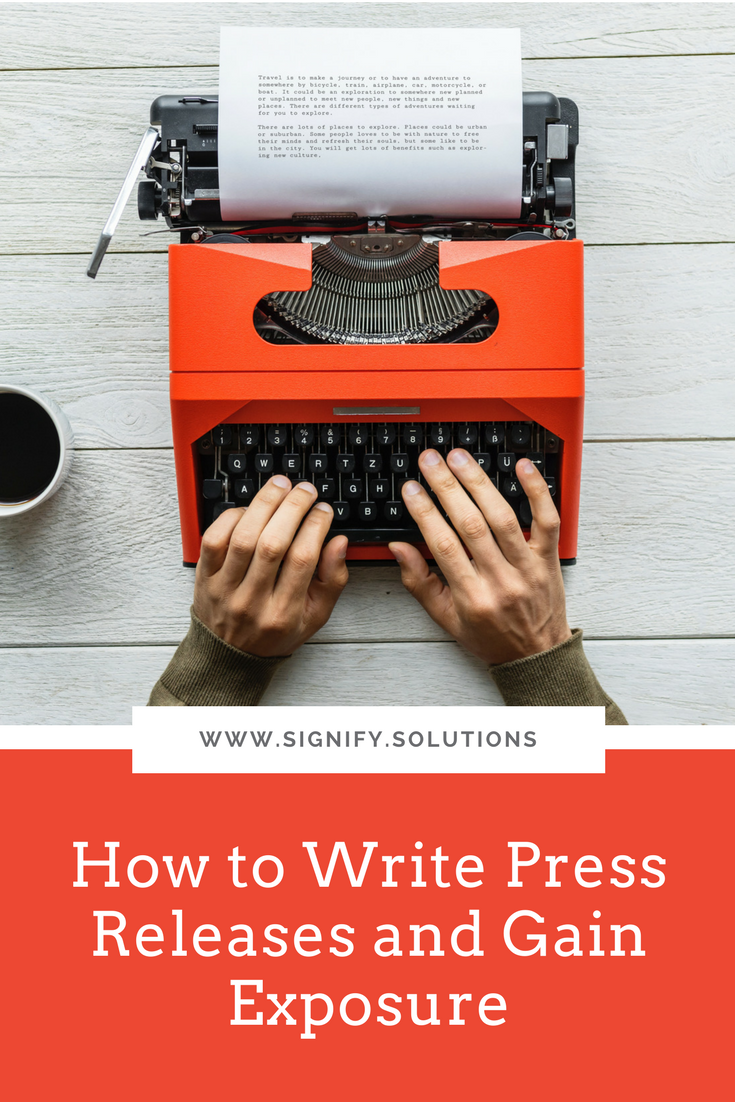As we’ve been learning lately, public relations is pretty essential for your business, especially if it’s a small business. People need to know what you’re doing and why they should care. And they can’t know until you tell them! So, how can you get your message out simply, effectively, and widely? Press releases.
Press releases are powerful marketing tools. If done correctly and distributed well, they can make a huge difference and boost your business tremendously. They are a way to get your name out to potential donors, partners, sponsors, and customers. They add to the credibility of your social enterprise or nonprofit and raise awareness for what you are doing.
Of course, writing press releases may be something you never thought to do, let alone how to do it. Don’t be intimidated! Follow these step-by-step guidelines and tips and you’ll be ready to showcase whatever you have to offer to the public—which is a lot!
First off, let’s talk about how to structure these babies. This is important, so take note!
Your headline should be short, sweet, to the point, and grab your audience’s attention immediately.
This is pretty much true for any headline out there, as you probably know. No one is going to choose to read something that has a weak, boring, or vague headline. This is arguably the most important part of your press release, because not only does this have to grab the public, it has to grab the journalist or the publication you want to help you distribute the release. If it doesn’t, it’s going straight into their trash. So make it good!
Think about who you’re trying to appeal to and cater it to them. You want to make it stand out and be captivating, but also capture the point of your release. Choose your words wisely and sparingly. Use strong words. Emotional words are beneficial to draw someone in and make them want to read more. Here’s a list of different emotional words you can use in your headline to evoke whatever action or feeling you need to.
Kristi also showed me an amazing tool that analyzes and grades your headline. It shows you exactly what you need to adjust to make it better and more effective. It’s fantastic. I find it’s much easier to write the entire thing first and then develop the headline, but it’s all preference! You can also add a sub-header with a bit more details if you think it’s absolutely necessary.
Now let’s move onto the juicy stuff…
Your first paragraph should contain your most important information and every detail your audience needs to know.
Don’t make people search for the point because they won’t. You need to make the point very clear and right off the bat. This is the time to give the who, what, when, where, why, and how. All details need to be clear and concise. What are you doing? Why is it important? Why should we care?
Set the scene for whatever it is you’re announcing. Don’t add any extra fluff. People can tell if you’re going around in circles or explaining something in five sentences when it could’ve been explained in one.
It’s also a good idea to have someone read this for you before you release it (really, they should read the entire thing, but especially this and the headline). If they can’t answer those questions when they’re done, you have more work to do.
In your next few paragraphs, you can include relevant and important quotes from relevant and important people only.
The body of your press release after your first paragraph should all just be support, but don’t get fluffy. Still keep it all short, sweet, and relevant to your main point. You don’t need quotes necessarily, but a one or two good ones can strengthen your narrative and make it interesting and credible. So use reliable sources!
I’m talking experts here—actual knowledgeable people. Don’t use a quote from your friend who’s only social media knowledge comes from her own personal Instagram use. Get a quote from a social media manager or specialist at a major company. They need to be powerful.
Focus these quotes around whatever message you’re trying to convey, too. It all needs to lead and connect to the same place. Don’t lead your audience on a wild goose chase for the point.
Remember these are still optional. Only use quotes if they strengthen your release and message. If you do use quotes, I would advise to only use one to three max in your press release. We’re going for quality over quantity here, so don’t get caught up in worrying about the length. Two pages maximum for this entire thing, preferably one.
If you don't use quotes or following your quotes, continue to expand on your first paragraph with supporting material. Start with what's most important or interesting, and work your way down. You only need a couple of paragraphs here.
In your last paragraph, you can provide some background information on your company and whatever it is you’re trying to spread the word about.
The least important information goes here, obviously. These are just some additional details that could be useful to people, but that won’t kill them to miss. You still want to only add what will strengthen your release.
You can include how the product/website/fundraiser/etc. was developed and how it will impact the future, if relevant. You can highlight additional resources you may have used or a website for purchases or more information. Just make sure you’re (say it with me now!) not adding fluff just to fill up the page.
Last but not least, your boilerplate is the very last component of your press release.
What is a boilerplate? In press releases, it’s a small, short paragraph that summarizes and tells the readers about your business. Think of it as a bio for your company. This should be the same for every press release. You will write this once and just tack it on the end of every one. Sounds easy, but don’t take it too lightly. It’s still important.
Keep this clear and straightforward, just a few sentences. Tell your readers who you are and what you do. It supports your credibility and can also boost your visibility on the web if you use key phrases, so make it count.
You also want to link to your website or other important platform in your boilerplate. For example, your last sentence could be, “For more information, visit: (insert your link here).” You should also include your contact information.
That’s the meat of your press release. Here are the other details you should include in formatting:
Your company letterhead and logo at the very top of the page
Underneath that, you should write “NEWS RELEASE” in bold on the left side of the page, the date under that, and “FOR IMMEDIATE RELEASE” underneath that
On the right side of the page you should include your information. Name, title, phone number, and email
The headline should come next on it’s own line, then the sub-header if you have one, then a space before the body of your release
In the first line before you start your first paragraph you should include a dateline in AP format. You can find how to correctly write a dateline here
If your release extends past one page, write “- more -” at the end of the first page
Use pound signs # # # # (yes, I said pound signs not hashtags! Am I really a Millennial?) to indicate the end of your press release.
Here’s a good, simple visual on all of that information:
So, now that you know how to format and write your press release, how do you distribute it and when? There’s no real rule here, but...
You should only try to distribute a press release when you have something actually important and newsworthy to share!
Some examples of things that are legitimately newsworthy are events, fundraisers, new product launches, product updates, website launches, or awards. It has to be meaningful, and not just to you but to the public.
In terms of how you should release it, you should start by posting it on your website, blog, and all social media platforms. You should also email it to local news publications and specific journalists. Do some research to find these. You want to send it to people and publications who cover your specific industry. Relevance is key!
Here are a few online press release distribution sites to help you get started.
PRLog.org - I use this one.
Atlanta Daybook - I use this one.
See, not too scary, right? You got this! I promise you, once you get it down, you’ll have it down forever, and you’ll gain so much more exposure for your business. Come back next week to learn more about how to build and form relationships with the media—more super important tips to grow your business and spread your mission!
Read all the posts in this PR series:
Megan Westbrook holds a B.A. in journalism with a focus in public relations and a minor in Spanish from Georgia State University. An aspiring writer, her interests reside in blogging, social media, content creation, design, and photography. She is also a passionate social justice advocate and interested in nonprofit or cause-focused work. Megan is currently a receptionist at Servcorp in Atlanta, Georgia.
PIN THIS POST FOR LATER:
I'm Kristi Porter, and I started Signify to provide writing, consulting and strategy services to nonprofits and for-profit organizations with a social mission, primarily through copywriting, marketing, and business communications. I believe that cause-focused organizations like yours are the future of business. You're proof that companies can both make money and do good. And I'm here to help you get noticed and grow. When you succeed, we all win.
















